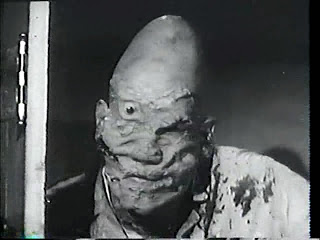“Carnival of Souls” represented, until just recently, another of the few holes in my movie-watching experience.
Between late-night and weekend afternoon TV airings in my youth (hello, “Francis the Talking Mule”) and rampant cable and home video watching in the 1980s and 90s, I had caught up on many movies that came out before my time, movies that played in theaters in the 20s, 30s, 40s, 50s and 60s.
But I hadn’t seen “Carnival of Souls” until just the other day, when I watched it on one of those multi-movie, public domain collections of horror films.
And I thought it was pretty good. It’s effective and creepy and fairly innovative for its time.
The movie, which is in the public domain and thus shows up on many home video collections of horror films, was released in 1962 and reportedly made by director Herk Harvey for $33,000.
The movie shows its bigger-than-it-has-any-right-to-be budget in its first scene. Two carloads of teenagers (?) drag race and one goes over the side of a bridge … and you actually see the car go off the bridge and into the water, not just impressions of movement and shocked expressions on faces.
Church organist Mary Henry (Candace Hilligoss) is the only survivor of the car that went into the river. Understandably rattled, Henry begins seeing a white-faced man peering at her through windows and in darkened corners.
When she’s introduced to an abandoned amusement park, she is drawn to the haunted place, a gathering place for ghosts.
The movie plays out like an episode of “The Twilight Zone,” but that’s okay. As plots go – no spoilers here, even after a half-century – the story for “Carnival of Souls” is spooky and effective.
Hilligoss, who made only one other film – “The Curse of the Living Corpse,” in 1964 – is pretty good in the movie. She’s sharp-edged and not particularly likable yet still manages to evoke our feelings of sympathy and curiosity. And she’s striking.
Speaking of striking: The movie’s visually quite stark and eye-catching. The black and white cinematography helps, but Harvey found great locations and let them well.
Random observations::
Raza Badiyi is listed as assistant director. He is really Reza Badiyi, who worked for another 40 years or so and directed the “Out of Mind, Out of Sight” episode of “Buffy the Vampire Slayer” in 1997, featuring an invisible girl. According to his IMDB page, he also shot the famous curling wave for the credits of “Hawaii Five-O.”
There’s lasting scare value to the scenes in which Hilligoss suddenly sees a white-faced figure looming toward her. The ghostly apparition is played by director Herk Harvey.
Department of unhelpful information, from the dialogue: “Hysteria won’t solve anything. Now control yourself!”









